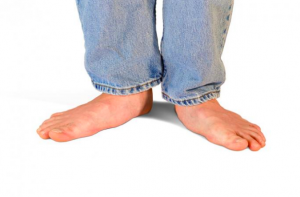 Having flat
feet describes
the biomechanical and structural positioning of one or both feet, which is characterised by rolling in at the ankles and showing little to
no arch on the inside border of a foot. This is how the term ‘fallen arches’ was coined. This is medically referred to
as pes planus, with the term for rolling in at the ankle joint when walking known as pronation. As the severity
of pronation can range from mild to severe, podiatrists can measure the angle of your shin bone relative to your calcaneus, or use a Foot
Posture Index (FPI), to help grade the level of pronation and best direct treatment where it is indicated. It
should be noted that:
Having flat
feet describes
the biomechanical and structural positioning of one or both feet, which is characterised by rolling in at the ankles and showing little to
no arch on the inside border of a foot. This is how the term ‘fallen arches’ was coined. This is medically referred to
as pes planus, with the term for rolling in at the ankle joint when walking known as pronation. As the severity
of pronation can range from mild to severe, podiatrists can measure the angle of your shin bone relative to your calcaneus, or use a Foot
Posture Index (FPI), to help grade the level of pronation and best direct treatment where it is indicated. It
should be noted that:
Flat feet are, however, linked with a greater incidence of foot problems because of the effect this position has on your bones, joints, muscles and ligaments. This happens because we over-pronate past the point that is necessary and healthy for our feet.
Typically, it comes down to the biomechanics of your feet and the way your bones, joints, muscles and ligaments are working together. Some people may have flat feet from birth and others may develop them over time and in association with other conditions. Causes may include:
In childhood, kids are born with the appearance of having flat feet when they are standing because their feet have fat pads. Most children outgrow it eventually as their feet get larger, their baby fat disappears and their foot muscles strengthen with weight bearing activity such as walking. If your child does not develop arches by the time they are 8 years old, it is not likely they will have an arch in adulthood.
The symptoms of flat feet aren’t necessarily painful themselves, but the stress and pressure they put on the surrounding tendons and structures can cause pain as tendinopathies and other issues develop. These tend to be exacerbated by long periods of time on the feet and high-impact activities. When podiatrists evaluate the severity of flat feet, they often look for signs as opposed to symptoms. These include:
Typically, treating flat feet is more to do with treating the problem the flat feet are creating or contributing to as opposed to treating flat-footedness itself. Where no symptoms or issues occur with flat feet, treatment may not be indicated. Generally, orthotics are a common way to alter the alignment and positioning of the feet and are used in the management of various conditions where overpronation is causing problems and pain. Having supportive footwear that stabilise the foot and ankle as opposed to letting it roll is also a key part of management. If you’re worried about the effect that your flat feet are having on the rest of your body, you should get assessed by your podiatrist. They’ll be able to show you the impact on your feet and legs and discuss with you the appropriate management options in light of your symptoms.
.png)
Since introducing shockwave therapy, we’ve helped many of our patients avoid surgery for certain conditions. Here's what you
need to know about shockwave treatment and how it works.
.png)
This Mother’s Day, consider a practical, medically safe, and confidence-boosting gift: a professional KeryFlex nail restoration treatment. It’s a simple, effective, and medically safe way to instantly transform the appearance of toenails.
Keeping your family on their feet and helping them to walk, run, play and exceed their goals is why we love getting up in the morning.
Ground Floor, One Health Building
122 Remuera Rd, Remuera
Auckland 1050, New Zealand
| MON - FRI | 7:30am – 6:30pm |
| SAT | 8:30am – 4:30pm |
| SUN | Some availability |
Make an Appointment
Online Schedule